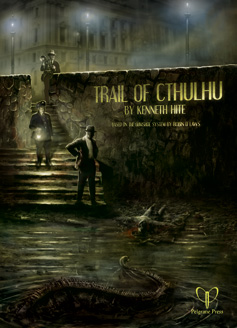
You may recall that earlier this year I got The Esoterrorists from Pelgrane Press, and thereafter I reported that I was looking forward to Trail of Cthulhu, the port of Call of Cthulhu over to the GUMSHOE system from Esoterrorists. Said book has released, and I finally got my hands on a copy. It is sweet. It's not as system-minimal as Esoterrorists (they added some chrome to make the system fit the Mythos and the 30s better), but it's still light enough to be something I'll happily run some day. Well worth the Amazon gift card I spent on it. (Thanks, Susan & Bill!) This is quickly becoming my favorite Cthulhu-themed RPG.
Far more than just a port, Trail of Cthulhu has plenty of new material as well. I love the bisociative way Kenneth Hite handles the big bads of the Cthulhu mythos. Each is defined by several intentionally contradictory bullet points / paragraphs. His sources include Lovecraft, Derleth, previous Cthulhu RPGs, other authors who have touched upon the mythos previously, and his own explorations. I particularly relish his notion of using scientific principles such as gravity, electromagnetism, strong and weak nuclear forces, etc, as if they were classical Elements. It's a very fresh and interesting take. Here's a sample:
"Azathoth" is the name given in the Necronomicon to "the monstrous nuclear chaos beyond angled space," the illusory personification of the Big Bang, just as "Thor" personifies lightning. The "invocation" or "summoning" of "Azathoth" is occult code for the release of atomic energy.
The only thing I don't like about the book is the golden ink used on certain page elements. It catches the light unevenly, and depending on the angles between book/lightsource/eye it shifts between painfully blinding, normal, near-invisible, and wonderfully eyecatching. Perhaps I should just be thankful the angles so far documented have yet to summon the Hounds of Tindalos.
I imagine some Call of Cthulhu purists will object to the very notion of Trail of Cthulhu, for exactly the inverse of the reason it was ported in the first place. In GUMSHOE games, players cannot miss a vital clue because of bad die rolls. Narratively, that total competence is just wonderful. I think any mystery game could benefit from this methodology, as it makes mystery-based RPGs finally able to replicate (without the GM having to cheat in the PCs favor) the experience of mystery novels and movies. However, I can see the point that will likely be made by some, that having a plotline stall out (and/or the world come to an end) because one PC failed a single critical investigation roll (and thus never saw one or more crucial clues / pieces of evidence) is very much in keeping with the bleak tone of Lovecraft's fiction. The trick is balancing the "insignificance of man" so endemic to the setting against the needs of dramatic narrative. CoC tells purer/bleaker mythos stories, but ToC is the better game.
No comments:
Post a Comment